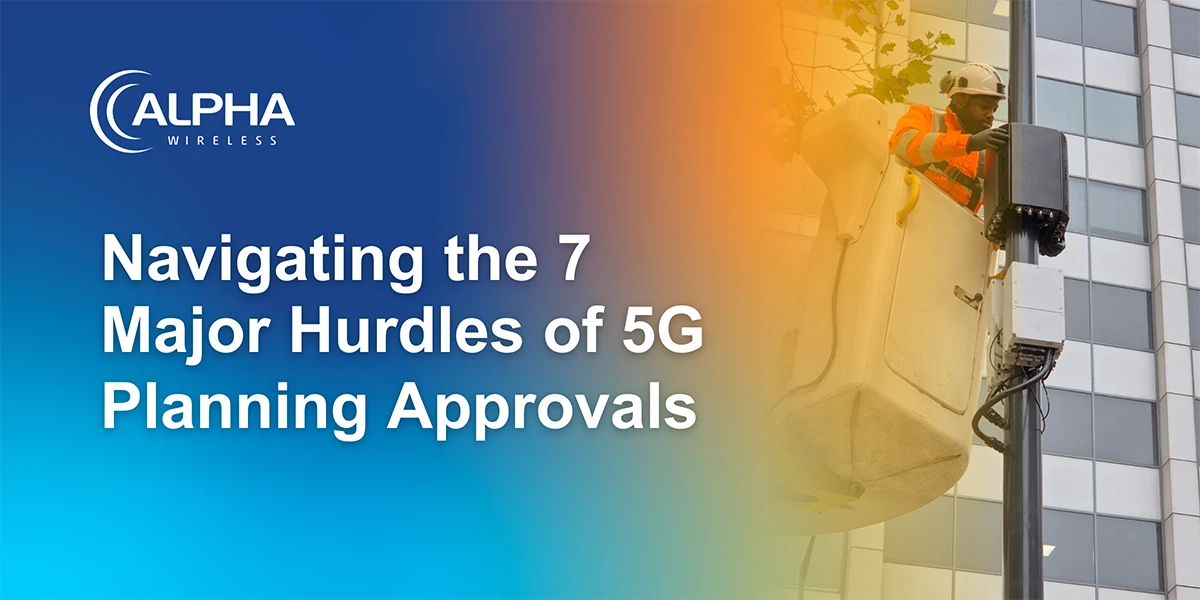
Introduction
Rolling out 5G networks is critical for economic growth and technological advancement, yet operators face significant planning hurdles. A 2024 Social Market Foundation report warned that planning delays could cost the UK billions in lost productivity, stalling innovation and economic development, and this is not a unique situation as countries globally race to achieve digital transformation, understanding and overcoming these challenges is essential.
Permitting Processes
One major obstacle in 5G deployment is navigating complex permitting processes. Compared to traditional mobile technologies, 5G networks require substantially more cell sites, significantly increasing planning applications. Traditional macro tower deployments might require fewer permits, whereas densified 5G networks may necessitate hundreds of permits within urban areas alone.
For operators, this increased density translates to substantial administrative workloads. According to industry estimates, a traditional macro tower permitting timeline averages 12 months. In contrast, the permitting process for multiple small cells needed for 5G densification can extend over several years if not properly managed.
Early engagement with councils and regulatory bodies is essential. Operators must clearly articulate the benefits of 5G and demonstrate adherence to zoning regulations. Utilizing regulatory compliance software like IBwave can simplify submissions, improving the accuracy of proposals and significantly reducing approval timelines.
To simplify permitting processes, solutions like Alpha Wireless’ Fusion Streetworks offer modular, aesthetically pleasing designs. Engineered to blend seamlessly into existing infrastructure, they significantly reduce visual objections, accelerating approvals and deployments.
Site Selection & Density
Millimeter-wave (mmWave) technology offers the high speeds and low latency promised by 5G, but its implementation brings unique technical challenges. mmWave frequencies have a shorter range and struggle significantly with building penetration and material interference. Operators must therefore strategically place cell sites in dense networks, often in line-of-sight positions to avoid signal blockage from foliage, buildings, or other structures.
Optimizing site selection becomes simpler with integrated solutions like Alpha Wireless’ Micro Streetworks. Their compact design and rapid deployment capabilities allow operators to efficiently densify urban networks while overcoming mmWave’s range limitations and ensuring consistent, high-quality 5G coverage.
Unlike previous technologies, where fewer, higher-powered towers could effectively cover large areas, 5G requires many small, closely placed cells to maintain performance. This increased site density amplifies the complexity and importance of accurate geographic information system (GIS) planning tools. Operators should leverage advanced GIS platforms to identify optimal cell locations and conduct precise line-of-sight analyses, dramatically reducing deployment risks and delays.
Aesthetic & Environmental Compliance
Community and regulatory resistance to new infrastructure often revolves around aesthetic and environmental concerns. Traditional macro towers, typically taller and more intrusive, faced fewer instances but more severe community pushback, as highlighted in the detailed Airways Advisors case study. Conversely, 5G’s extensive small cell deployments face frequent aesthetic scrutiny, especially in protected areas and urban centers where visual clutter is highly regulated, as explained in the ASLA Dirt article.
Solutions such as Alpha Wireless’ Macro Streetworks deliver high-capacity coverage in a small, visually discreet footprint, easing compliance with stringent aesthetic regulations. Their sleek design helps operators mitigate visual clutter concerns, simplifying approvals in even the most regulated urban spaces.
In the UK and Europe, infrastructure must meet strict visual guidelines, avoiding obstructions to pavements and minimizing skyline disruptions. Operators must invest in aesthetically pleasing, integrated infrastructure solutions that meet regulatory standards. Collaborating closely with local planners early in the design process ensures compatibility with existing urban aesthetics, significantly improving the likelihood of swift approvals.
Regulatory Inconsistencies
Inconsistent regulations across regions further complicate 5G deployments. While previous technologies faced regulatory scrutiny, 5G’s dense, cross-border network infrastructure magnifies these challenges. For instance, different municipalities may have conflicting zoning laws, emission standards, or permit requirements.
Neutral hosts and operators deploying infrastructure across multiple jurisdictions face considerable logistical burdens. Developing universal compliance frameworks and maintaining ongoing dialogues with regulatory bodies help navigate these inconsistencies. Participation in industry associations and standardization bodies can streamline processes, advocating for more unified and transparent regulatory practices.
To address regional regulatory variations, utilizing standardized, scalable infrastructure like Alpha Wireless’ Telecom Streetworks Solutions enables easier replication across multiple jurisdictions, streamlining cross-border compliance and reducing overall administrative burdens.
Local Resource Constraints
Planning departments often lack the resources to manage the increased volume and complexity of 5G applications effectively. Traditional macro sites required fewer, more straightforward approvals, allowing for a manageable administrative burden. In contrast, the exponential increase in small cell applications for 5G puts enormous strain on local resources, exacerbating delays (FCC Report).
Operators must proactively collaborate with local authorities, possibly even supporting the enhancement of administrative capacity through dedicated funding or staffing partnerships. Encouraging digital submissions and standardized application formats can also dramatically streamline internal planning processes, alleviating bottlenecks and speeding approvals.
Technical Integration Challenges
Deploying 5G requires seamless integration of advanced technologies like virtualized Radio Access Networks (vRAN), Radio-over-Ethernet (RoE), and beamforming. Beamforming, in particular, introduces complexities by dynamically adjusting signal directions to maintain optimal connectivity, complicating site placement and network planning.
Operators must thoroughly test and validate integration processes through pilot deployments, ensuring interoperability with existing legacy infrastructure. Investing in flexible network architectures and modular infrastructure designs simplifies future upgrades and maintenance, minimizing long-term integration issues.
Conclusion
Achieving timely 5G network deployments demands operators navigate and address these diverse planning hurdles effectively. By understanding the intricacies of permitting, technical demands, and community engagement, operators can strategically overcome barriers, unlocking the transformative economic and social potential of 5G technology.
Ready to accelerate your 5G deployment strategy? Contact us to explore tailored Telecom Streetworks Solutions designed to streamline your infrastructure projects.
